16.4: Interactions with Sound Waves
- Page ID
- 14539
\( \newcommand{\vecs}[1]{\overset { \scriptstyle \rightharpoonup} {\mathbf{#1}} } \)
\( \newcommand{\vecd}[1]{\overset{-\!-\!\rightharpoonup}{\vphantom{a}\smash {#1}}} \)
\( \newcommand{\dsum}{\displaystyle\sum\limits} \)
\( \newcommand{\dint}{\displaystyle\int\limits} \)
\( \newcommand{\dlim}{\displaystyle\lim\limits} \)
\( \newcommand{\id}{\mathrm{id}}\) \( \newcommand{\Span}{\mathrm{span}}\)
( \newcommand{\kernel}{\mathrm{null}\,}\) \( \newcommand{\range}{\mathrm{range}\,}\)
\( \newcommand{\RealPart}{\mathrm{Re}}\) \( \newcommand{\ImaginaryPart}{\mathrm{Im}}\)
\( \newcommand{\Argument}{\mathrm{Arg}}\) \( \newcommand{\norm}[1]{\| #1 \|}\)
\( \newcommand{\inner}[2]{\langle #1, #2 \rangle}\)
\( \newcommand{\Span}{\mathrm{span}}\)
\( \newcommand{\id}{\mathrm{id}}\)
\( \newcommand{\Span}{\mathrm{span}}\)
\( \newcommand{\kernel}{\mathrm{null}\,}\)
\( \newcommand{\range}{\mathrm{range}\,}\)
\( \newcommand{\RealPart}{\mathrm{Re}}\)
\( \newcommand{\ImaginaryPart}{\mathrm{Im}}\)
\( \newcommand{\Argument}{\mathrm{Arg}}\)
\( \newcommand{\norm}[1]{\| #1 \|}\)
\( \newcommand{\inner}[2]{\langle #1, #2 \rangle}\)
\( \newcommand{\Span}{\mathrm{span}}\) \( \newcommand{\AA}{\unicode[.8,0]{x212B}}\)
\( \newcommand{\vectorA}[1]{\vec{#1}} % arrow\)
\( \newcommand{\vectorAt}[1]{\vec{\text{#1}}} % arrow\)
\( \newcommand{\vectorB}[1]{\overset { \scriptstyle \rightharpoonup} {\mathbf{#1}} } \)
\( \newcommand{\vectorC}[1]{\textbf{#1}} \)
\( \newcommand{\vectorD}[1]{\overrightarrow{#1}} \)
\( \newcommand{\vectorDt}[1]{\overrightarrow{\text{#1}}} \)
\( \newcommand{\vectE}[1]{\overset{-\!-\!\rightharpoonup}{\vphantom{a}\smash{\mathbf {#1}}}} \)
\( \newcommand{\vecs}[1]{\overset { \scriptstyle \rightharpoonup} {\mathbf{#1}} } \)
\( \newcommand{\vecd}[1]{\overset{-\!-\!\rightharpoonup}{\vphantom{a}\smash {#1}}} \)
\(\newcommand{\avec}{\mathbf a}\) \(\newcommand{\bvec}{\mathbf b}\) \(\newcommand{\cvec}{\mathbf c}\) \(\newcommand{\dvec}{\mathbf d}\) \(\newcommand{\dtil}{\widetilde{\mathbf d}}\) \(\newcommand{\evec}{\mathbf e}\) \(\newcommand{\fvec}{\mathbf f}\) \(\newcommand{\nvec}{\mathbf n}\) \(\newcommand{\pvec}{\mathbf p}\) \(\newcommand{\qvec}{\mathbf q}\) \(\newcommand{\svec}{\mathbf s}\) \(\newcommand{\tvec}{\mathbf t}\) \(\newcommand{\uvec}{\mathbf u}\) \(\newcommand{\vvec}{\mathbf v}\) \(\newcommand{\wvec}{\mathbf w}\) \(\newcommand{\xvec}{\mathbf x}\) \(\newcommand{\yvec}{\mathbf y}\) \(\newcommand{\zvec}{\mathbf z}\) \(\newcommand{\rvec}{\mathbf r}\) \(\newcommand{\mvec}{\mathbf m}\) \(\newcommand{\zerovec}{\mathbf 0}\) \(\newcommand{\onevec}{\mathbf 1}\) \(\newcommand{\real}{\mathbb R}\) \(\newcommand{\twovec}[2]{\left[\begin{array}{r}#1 \\ #2 \end{array}\right]}\) \(\newcommand{\ctwovec}[2]{\left[\begin{array}{c}#1 \\ #2 \end{array}\right]}\) \(\newcommand{\threevec}[3]{\left[\begin{array}{r}#1 \\ #2 \\ #3 \end{array}\right]}\) \(\newcommand{\cthreevec}[3]{\left[\begin{array}{c}#1 \\ #2 \\ #3 \end{array}\right]}\) \(\newcommand{\fourvec}[4]{\left[\begin{array}{r}#1 \\ #2 \\ #3 \\ #4 \end{array}\right]}\) \(\newcommand{\cfourvec}[4]{\left[\begin{array}{c}#1 \\ #2 \\ #3 \\ #4 \end{array}\right]}\) \(\newcommand{\fivevec}[5]{\left[\begin{array}{r}#1 \\ #2 \\ #3 \\ #4 \\ #5 \\ \end{array}\right]}\) \(\newcommand{\cfivevec}[5]{\left[\begin{array}{c}#1 \\ #2 \\ #3 \\ #4 \\ #5 \\ \end{array}\right]}\) \(\newcommand{\mattwo}[4]{\left[\begin{array}{rr}#1 \amp #2 \\ #3 \amp #4 \\ \end{array}\right]}\) \(\newcommand{\laspan}[1]{\text{Span}\{#1\}}\) \(\newcommand{\bcal}{\cal B}\) \(\newcommand{\ccal}{\cal C}\) \(\newcommand{\scal}{\cal S}\) \(\newcommand{\wcal}{\cal W}\) \(\newcommand{\ecal}{\cal E}\) \(\newcommand{\coords}[2]{\left\{#1\right\}_{#2}}\) \(\newcommand{\gray}[1]{\color{gray}{#1}}\) \(\newcommand{\lgray}[1]{\color{lightgray}{#1}}\) \(\newcommand{\rank}{\operatorname{rank}}\) \(\newcommand{\row}{\text{Row}}\) \(\newcommand{\col}{\text{Col}}\) \(\renewcommand{\row}{\text{Row}}\) \(\newcommand{\nul}{\text{Nul}}\) \(\newcommand{\var}{\text{Var}}\) \(\newcommand{\corr}{\text{corr}}\) \(\newcommand{\len}[1]{\left|#1\right|}\) \(\newcommand{\bbar}{\overline{\bvec}}\) \(\newcommand{\bhat}{\widehat{\bvec}}\) \(\newcommand{\bperp}{\bvec^\perp}\) \(\newcommand{\xhat}{\widehat{\xvec}}\) \(\newcommand{\vhat}{\widehat{\vvec}}\) \(\newcommand{\uhat}{\widehat{\uvec}}\) \(\newcommand{\what}{\widehat{\wvec}}\) \(\newcommand{\Sighat}{\widehat{\Sigma}}\) \(\newcommand{\lt}{<}\) \(\newcommand{\gt}{>}\) \(\newcommand{\amp}{&}\) \(\definecolor{fillinmathshade}{gray}{0.9}\)learning objectives
- Identify conditions required for the superposition of two waves
Waves are most commonly described by variations in some parameter through space and time—height in a water wave, pressure in a sound wave, or the electromagnetic field in a light wave. The value of this parameter is called the amplitude of the wave; the wave itself is a function specifying the amplitude at each point.
When two or more waves arrive at the same point, they superimpose themselves onto one another. More specifically, the disturbances of waves are superimposed when they come together (a phenomenon called superposition). Each disturbance corresponds to a force, or amplitude (and the forces add). If the disturbances are along the same line, the resulting wave is a simple addition of the disturbances of the individual waves. That is, their amplitudes add.
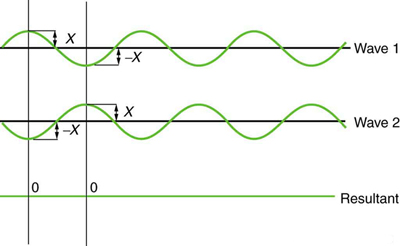
Superposition: Superposition is when two waves add together. In this figure, the two waves add together and cancel out leaving no wave. This is destructive interference.
Superposition of waves leads to what is known as interference, which manifests in two types: constructive and destructive. Constructive interference occurs when two waves add together in superposition, creating a wave with cumulatively higher amplitude, as shown in. In destructive interference, the two waves add together but cancel out (like adding a positive and negative number). Destructive interference is shown in.
While pure constructive and pure destructive interference do occur, they require precisely aligned identical waves. The superposition of most waves produces a combination of constructive and destructive interference, and can vary from place to place and time to time. Sound from a stereo, for example, can be loud in one spot but quiet in another. Varying loudness means the sound waves add partially constructively and partially destructively at different locations. A stereo has at least two speakers creating sound waves, and waves can reflect from walls. All these waves superimpose. An example of sounds that vary over time from constructive to destructive is found in the combined whine of airplane jets heard by a stationary passenger. The combined sound can fluctuate up and down in volume as the sound from the two engines varies in time from constructive to destructive.
These examples are of waves that are similar. illustrates that when non-identical waves superimpose, the outcome is a mixture of constructive and destructive interference.

Superposition of Non-Identical Waves: Superposition of non-identical waves exhibits both constructive and destructive interference.
Interference
Interference occurs when multiple waves interact with each other, and is a change in amplitude caused by several waves meeting.
learning objectives
- Contrast constructive and destructive interference
Unlike solid objects, two waves can share a point in space. In physics, interference is a phenomenon in which two waves (passing through the same point) superimpose to form a resultant wave of greater or lower amplitude. Interference usually refers to the interaction of waves that are correlated or coherent with each other (i.e, “interfere” with each other), either because they come from the same source or because they have the same or nearly the same frequency.
The effects of interference can be observed with all types of waves, for example, light, radio, acoustic and surface water waves. The idea that interference is caused by superposition means that when two waves meet their two amplitudes (their maximum absolute value) combine together.
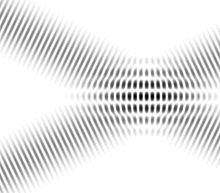
Interference: Two overlapping waves exhibit interference.
Interference can be constructive or destructive. In constructive interference, the two amplitudes of the waves add together and result in a higher displacement than would have been the case if there were only one wave. An example of constructive interference may be seen in.
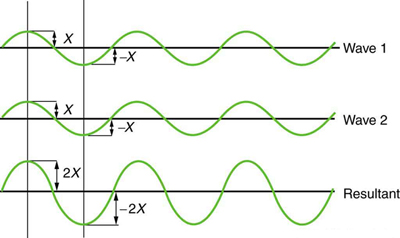
Constructive Interference: Pure constructive interference of two identical waves produces one with twice the amplitude, but the same wavelength.
Destructive interference is when two waves add together and the result is a smaller displacement than would have been the case. An example of destructive interference can be seen in. When the waves have opposite amplitudes at the point they meet they can destructively interfere, resulting in no amplitude at that point. For example, this is how noise cancelling headphones work. By playing a sound with the opposite amplitude as the incoming sound, the two sound waves destructively interfere and this cancel each other out.
Beats
The superposition of two waves of similar but not identical frequencies produces a pulsing known as a beat.
learning objectives
- Identify superposition conditions that lead to beat
Striking two adjacent keys on a piano produces a warbling combination (usually considered unpleasant to the ear). The culprit is the superposition of two waves of similar but not identical frequencies. When two waves of similar frequency arrive at the same point and superimpose, they alternately constructively and destructively interfere. This alternating is known as a beat because it produces an unpleasant pulsing sound.
Another example is often noticeable in a taxiing jet aircraft (particularly the two-engine variety). The loudness of the combined sound of the engines increases and decreases. This varying loudness occurs because the sound waves have similar but not identical frequencies. The discordant warbling of the piano and the fluctuating loudness of the jet engine noise are both due to alternately constructive and destructive interference as the two waves go in and out of phase. illustrates this phenomenon graphically.

Beat Frequency: Beats are produced by the superposition of two waves of slightly different frequencies but identical amplitudes.The waves alternate in time between constructive interference and destructive interference, giving the resulting wave a time-varying amplitude.
The wave resulting from the superposition of two similar-frequency waves has a frequency that is the average of the two. This wave fluctuates in amplitude, or beats, with a frequency called the beat frequency. We can determine the beat frequency mathematically by adding two waves together.
One can also measure the beat frequency directly. When you hear a beat coming from two discordant sounds (say, two notes on a piano) you can count the number of beats per second. The number of beats per second, or the beat frequency, shows the difference in frequency between the two notes. Musicians often use this phenomena to ensure that two notes are in tune (if they are in tune then there are no beats).
The Ear
The ear is the sensory organ that picks up sound waves from the air and turns them into nerve impulses that can be sent to the brain.
learning objectives
- Describe how sound waves are collected and transformed into nerve impulses
Sound waves are vibrations in the air. The ear is the sensory organ that picks up sound waves from the surrounding air and turns them into nerve impulses, which are then sent to the brain. The sound waves carry a lot of information — language, music, and noise — all mixed together. The task of the ear is to turn the signals in these waves of bouncing air molecules into electrical nerve signals while keeping as much of the information in the signal as possible. (It’s the brain’s job to then sort the signals and make sense of them. ) It’s not easy to turn one kind of signal into another without losing information, but the ear is well designed for the task.
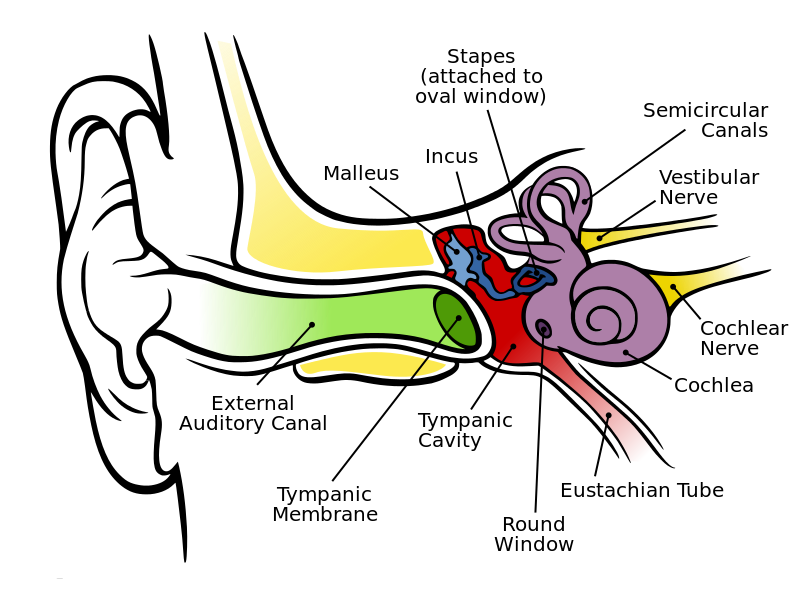
Anatomy of the Human Ear: Anatomy of the human ear; the length of the auditory canal is exaggerated for viewing purposes
Air surrounds the head and fills the ear canal and middle ear. Therefore, when the outer part of the ear collects sound and the middle ear amplifies this sound pressure, these processes occur in the medium of air. However, the hollow channels of the inner ear (which is embedded in the temporal bone, the densest bone of the body) are filled with liquid. So as the sound travels into the inner ear, it passes from the medium of air into a liquid medium. These inner-ear channels contain a sensory epithelium that is studded with hair cells. The microscopic “hairs” are structural protein filaments that project out into the fluid. The hair cells release a chemical neurotransmitter when stimulated. Sound waves moving through fluid push the filaments; if the filaments bend over enough, the hair cells fire chemical signals. In this way sound waves are transformed into nerve impulses. The nerve impulses travel from the left and right ears through the eighth cranial nerve to both sides of the brain stem and up to the part of the cerebral cortex dedicated to sound (auditory cortex, located in the temporal lobe).
Applications: Ultrasound, Sonar, and Medical Imaging
Sound waves reflect off different materials differently (when the reflections are collected, they can provide information and images).
learning objectives
- Discuss application of sound waves in medicine and navigation
The controlled use of sound waves has many applications in science. Controlled reflection of such waves allows images to be received.
Ultrasound
Ultrasound is sound with a frequency higher than 20 kHz. This is above the human range of hearing. The most common use of ultrasound, creating images, has industrial and medical applications. The use of ultrasound to create images is based on the reflection and transmission of a wave at a boundary. When an ultrasound wave travels inside an object that is made up of different materials (such as the human body), each time it encounters a boundary (e.g., between bone and muscle, or muscle and fat), part of the wave is reflected and part of it is transmitted. The reflected rays are detected and used to construct an image of the object.
Sonar
illustrates how a ship on the ocean utilizes the reflecting properties of sound waves to determine the depth of the ocean. A sound wave is transmitted and bounces off the seabed. Because the speed of sound is known and the time lapse between sending and receiving the sound can be measured, the distance from the ship to the bottom of the ocean can be determined. This technique is called sonar (originally an acronym for SOund Navigation And Ranging).
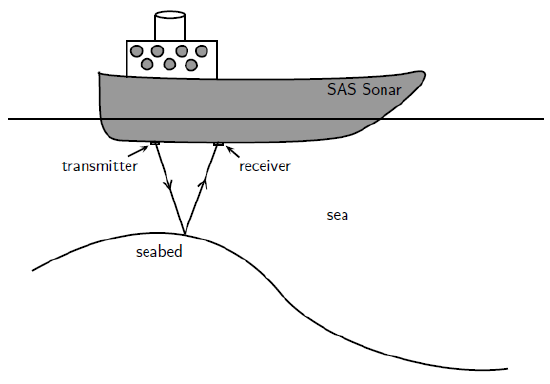
Sonar: Ships on the ocean make use of the reflecting properties of sound waves to determine the depth of the ocean. A sound wave is transmitted and bounces off the seabed. Because the speed of sound is known and the time lapse between sending and receiving the sound can be measured, the distance from the ship to the bottom of the ocean can be determined.
Just as ships on the ocean, certain animals, like dolphins and bats, make use of sounds waves (sonar) to navigate or find their way. Ultrasound waves are sent out then reflected off the objects around the animal. Bats or dolphins then use the reflected sounds to form a “picture” of their surroundings (this is known as echolocation).
Key Points
- When two waves occupy the same point, superposition occurs. Superposition results in adding the two waves together.
- Constructive interference is when two waves superimpose and the resulting wave has a higher amplitude than the previous waves.
- Destructive interference is when two waves superimpose and cancel each other out, leading to a lower amplitude.
- Most wave superpositions involve a mixture of constructive and destructive interference since the waves are not perfectly identical.
- Interference is a phenomenon of wave interactions. When two waves meet at a point, they interfere with each other.
- There are two types of interference, constructive and destructive.
- In constructive interference, the amplitudes of the two waves add together resulting in a higher wave at the point they meet.
- In destructive interference, the two waves cancel out resulting in a lower amplitude at the point they meet.
- When two waves of similar frequencies interfere, the result is a beat frequency.
- A beat frequency is a pulsing sound that goes up and down in loudness.
- As the two waves go in and out of phase, the varying constructive and destructive interference makes the wave grow and shrink in amplitude. For sound waves this produces a beating sound.
- The task of the ear is to turn the signals in the waves of bouncing air molecules into electrical nerve signals while keeping as much of the information in the signals as possible.
- Sound is collected in the outer part of the ear; sound pressure is amplified through the middle part of the ear and is passed from the medium of air into a liquid medium.
- That sound pressure is amplified through the middle portion of the ear and passed from the medium of air into a liquid medium.
- Sound waves moving through the fluid in the inner ear stimulate hair cells, making them release chemical neurotransmitters. In this way sound waves are transformed into nerve impulses.
- When waves encounter a boundary between two materials, part of the wave is reflected and part is transmitted.
- By using high frequency sound waves, doctors can create images of parts of the body normally not visible.
- By transmitting sound waves and measuring the time between the transmission and receiving the reflection, ships can use sound waves to navigate. This is called sonar.
Key Terms
- superimpose: To place an object over another object.
- displacement: A vector quantity that denotes distance with a directional component.
- amplitude: The maximum absolute value of some quantity that varies.
- coherent: Of waves having the same direction, wavelength and phase, as light in a laser.
- frequency: The quotient of the number of times n a periodic phenomenon occurs over the time tt in which it occurs: \(\mathrm{f=n/t\).
- interfere: (of waves) To be correlated with each other when overlapped or superposed.
- superposition: The summing of two or more field contributions occupying the same space.
- epithelium: a membranous tissue composed of one or more layers of cells that forms the covering of most internal and external surfaces of the body and its organs (internally, the lining of vessels and other small cavities; externally, the skin)
- nerve impulse: the signal transmitted along a nerve fiber, either in response to a stimulus (such as touch, pain, or heat), or as an instruction (such as causing a muscle to contract)
- neurotransmitter: any substance, such as acetylcholine or dopamine, responsible for sending nerve signals across a synapse between two neurons
LICENSES AND ATTRIBUTIONS
CC LICENSED CONTENT, SHARED PREVIOUSLY
- Curation and Revision. Provided by: Boundless.com. License: CC BY-SA: Attribution-ShareAlike
CC LICENSED CONTENT, SPECIFIC ATTRIBUTION
- OpenStax College, Superposition and Interference. September 17, 2013. Provided by: OpenStax CNX. Located at: http://cnx.org/content/m42249/latest/. License: CC BY: Attribution
- Superposition principle. Provided by: Wikipedia. Located at: en.Wikipedia.org/wiki/Superposition_principle%23Application_to_waves. License: CC BY-SA: Attribution-ShareAlike
- OpenStax College, Superposition and Interference. September 17, 2013. Provided by: OpenStax CNX. Located at: http://cnx.org/content/m42249/latest/. License: CC BY: Attribution
- superimpose. Provided by: Wiktionary. Located at: en.wiktionary.org/wiki/superimpose. License: CC BY-SA: Attribution-ShareAlike
- OpenStax College, Superposition and Interference. January 16, 2015. Provided by: OpenStax CNX. Located at: http://cnx.org/content/m42249/latest/. License: CC BY: Attribution
- OpenStax College, Superposition and Interference. January 16, 2015. Provided by: OpenStax CNX. Located at: http://cnx.org/content/m42249/latest/. License: CC BY: Attribution
- Superposition. Provided by: Wikipedia. Located at: en.Wikipedia.org/wiki/Superposition. License: CC BY-SA: Attribution-ShareAlike
- amplitude. Provided by: Wiktionary. Located at: en.wiktionary.org/wiki/amplitude. License: CC BY-SA: Attribution-ShareAlike
- coherent. Provided by: Wiktionary. Located at: en.wiktionary.org/wiki/coherent. License: CC BY-SA: Attribution-ShareAlike
- displacement. Provided by: Wiktionary. Located at: en.wiktionary.org/wiki/displacement. License: CC BY-SA: Attribution-ShareAlike
- OpenStax College, Superposition and Interference. January 16, 2015. Provided by: OpenStax CNX. Located at: http://cnx.org/content/m42249/latest/. License: CC BY: Attribution
- OpenStax College, Superposition and Interference. January 16, 2015. Provided by: OpenStax CNX. Located at: http://cnx.org/content/m42249/latest/. License: CC BY: Attribution
- Interference. Provided by: Wikipedia. Located at: en.Wikipedia.org/wiki/Interference. License: CC BY: Attribution
- OpenStax College, Superposition and Interference. February 6, 2013. Provided by: OpenStax CNX. Located at: http://cnx.org/content/m42249/latest/. License: CC BY: Attribution
- OpenStax College, Superposition and Interference. September 17, 2013. Provided by: OpenStax CNX. Located at: http://cnx.org/content/m42249/latest/. License: CC BY: Attribution
- frequency. Provided by: Wiktionary. Located at: en.wiktionary.org/wiki/frequency. License: CC BY-SA: Attribution-ShareAlike
- interfere. Provided by: Wiktionary. Located at: en.wiktionary.org/wiki/interfere. License: CC BY-SA: Attribution-ShareAlike
- Boundless. Provided by: Boundless Learning. Located at: www.boundless.com//physics/definition/superposition. License: CC BY-SA: Attribution-ShareAlike
- OpenStax College, Superposition and Interference. January 16, 2015. Provided by: OpenStax CNX. Located at: http://cnx.org/content/m42249/latest/. License: CC BY: Attribution
- OpenStax College, Superposition and Interference. January 16, 2015. Provided by: OpenStax CNX. Located at: http://cnx.org/content/m42249/latest/. License: CC BY: Attribution
- Interference. Provided by: Wikipedia. Located at: en.Wikipedia.org/wiki/Interference. License: CC BY: Attribution
- OpenStax College, Superposition and Interference. February 6, 2013. Provided by: OpenStax CNX. Located at: http://cnx.org/content/m42249/latest/. License: CC BY: Attribution
- OpenStax College, Superposition and Interference. February 9, 2013. Provided by: OpenStax CNX. Located at: http://cnx.org/content/m42249/latest/Figure_17_10_08a.jpg. License: CC BY: Attribution
- Catherine Schmidt-Jones, Sound and Ears. September 17, 2013. Provided by: OpenStax CNX. Located at: http://cnx.org/content/m12365/latest/. License: CC BY: Attribution
- Ear. Provided by: Wikipedia. Located at: en.Wikipedia.org/wiki/Ear. License: CC BY-SA: Attribution-ShareAlike
- epithelium. Provided by: Wiktionary. Located at: en.wiktionary.org/wiki/epithelium. License: CC BY-SA: Attribution-ShareAlike
- neurotransmitter. Provided by: Wiktionary. Located at: en.wiktionary.org/wiki/neurotransmitter. License: CC BY-SA: Attribution-ShareAlike
- nerve impulse. Provided by: Wiktionary. Located at: en.wiktionary.org/wiki/nerve_impulse. License: CC BY-SA: Attribution-ShareAlike
- OpenStax College, Superposition and Interference. January 16, 2015. Provided by: OpenStax CNX. Located at: http://cnx.org/content/m42249/latest/. License: CC BY: Attribution
- OpenStax College, Superposition and Interference. January 16, 2015. Provided by: OpenStax CNX. Located at: http://cnx.org/content/m42249/latest/. License: CC BY: Attribution
- Interference. Provided by: Wikipedia. Located at: en.Wikipedia.org/wiki/Interference. License: CC BY: Attribution
- OpenStax College, Superposition and Interference. February 6, 2013. Provided by: OpenStax CNX. Located at: http://cnx.org/content/m42249/latest/. License: CC BY: Attribution
- OpenStax College, Superposition and Interference. February 9, 2013. Provided by: OpenStax CNX. Located at: http://cnx.org/content/m42249/latest/Figure_17_10_08a.jpg. License: CC BY: Attribution
- Anatomy of the Human Ear. Provided by: Wikipedia. Located at: en.Wikipedia.org/wiki/File:Anatomy_of_the_Human_Ear.svg. License: CC BY: Attribution
- Free High School Science Texts Project, Sound: Applications. September 17, 2013. Provided by: OpenStax CNX. Located at: http://cnx.org/content/m38800/latest/. License: CC BY: Attribution
- Free High School Science Texts Project, Sound: Applications. September 17, 2013. Provided by: OpenStax CNX. Located at: http://cnx.org/content/m38800/latest/. License: CC BY: Attribution
- frequency. Provided by: Wiktionary. Located at: en.wiktionary.org/wiki/frequency. License: CC BY-SA: Attribution-ShareAlike
- OpenStax College, Superposition and Interference. January 16, 2015. Provided by: OpenStax CNX. Located at: http://cnx.org/content/m42249/latest/. License: CC BY: Attribution
- OpenStax College, Superposition and Interference. January 16, 2015. Provided by: OpenStax CNX. Located at: http://cnx.org/content/m42249/latest/. License: CC BY: Attribution
- Interference. Provided by: Wikipedia. Located at: en.Wikipedia.org/wiki/Interference. License: CC BY: Attribution
- OpenStax College, Superposition and Interference. February 6, 2013. Provided by: OpenStax CNX. Located at: http://cnx.org/content/m42249/latest/. License: CC BY: Attribution
- OpenStax College, Superposition and Interference. February 9, 2013. Provided by: OpenStax CNX. Located at: http://cnx.org/content/m42249/latest/Figure_17_10_08a.jpg. License: CC BY: Attribution
- Anatomy of the Human Ear. Provided by: Wikipedia. Located at: en.Wikipedia.org/wiki/File:Anatomy_of_the_Human_Ear.svg. License: CC BY: Attribution
- Free High School Science Texts Project, Sound: Applications. February 8, 2013. Provided by: OpenStax CNX. Located at: http://cnx.org/content/m38800/latest/PG11C5_005.png. License: CC BY: Attribution


